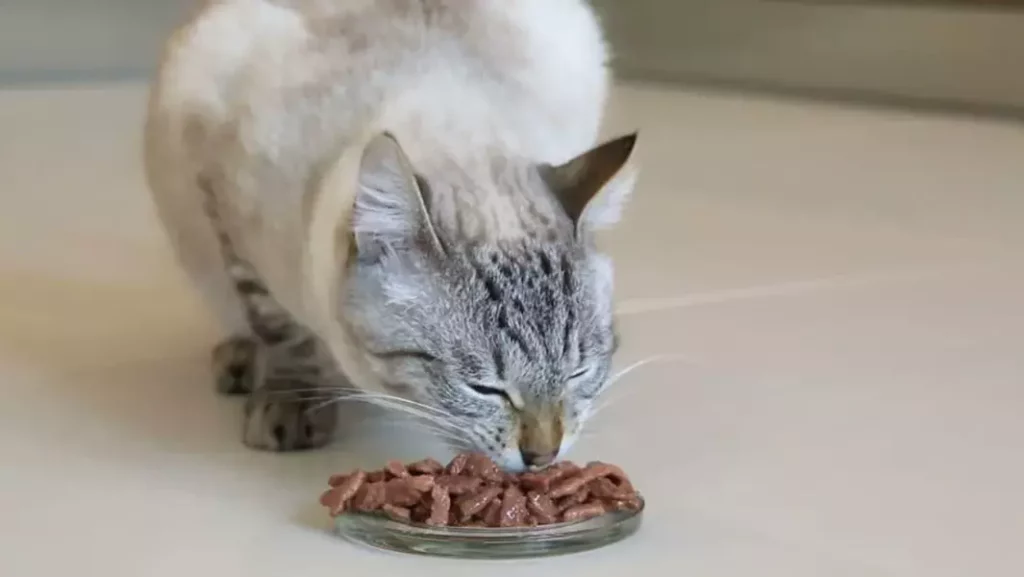Cats are obligate carnivores, meaning their physiology is uniquely adapted to thrive on diets rich in animal-based proteins and moisture, with minimal reliance on carbohydrates.
Their evolutionary biology demands:
- High-protein intake: Essential for maintaining lean muscle mass, supporting metabolic functions, and promoting overall vitality.
- Low-carbohydrate requirements: Unlike omnivores, cats lack specific digestive enzymes to efficiently process carbs, making high-carb diets a potential contributor to obesity and diabetes.
- Hydration dependency: Cats have a naturally low thirst drive, relying heavily on dietary moisture to sustain kidney function and urinary tract health.
This biological framework underscores why nutrient-dense, moisture-rich foods align with their physiological demands.
Rise of Wet Cat Food
The growing preference for canned diets reflects a shift toward biologically appropriate feeding practices. Key drivers include:
- Protein-first formulation: Modern wet foods prioritize meat-based proteins, mirroring the nutrient profile of a cat’s ancestral diet. This aligns with research showing high-protein, low-carb diets help preserve muscle mass during weight loss.
- Hydration advantages: With water content exceeding 70%, canned diets address cats’ susceptibility to dehydration, a critical factor in managing chronic conditions like chronic kidney disease.
- Digestive and metabolic health: Reduced caloric density and carb content in wet cat food lowers risks of obesity and insulin resistance, while enhanced palatability encourages consistent eating habits.
- Clinical benefits: Studies note wet diets improve post-surgical recovery, reduce pain, and boost antioxidant activity, highlighting their therapeutic potential.
As pet owners prioritize species-specific nutrition, wet cat food’s alignment with feline biology cements its role as a cornerstone of modern cat care.
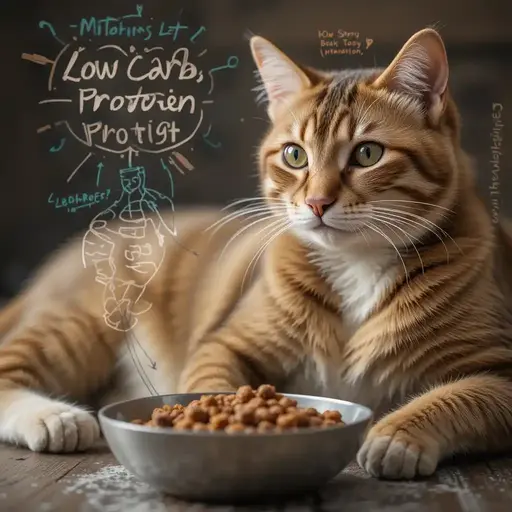
The Science Behind Wet Cat Food
Nutritional Composition Compared to Dry Food
Wet diets are formulated to mirror the biological needs of obligate carnivores, offering distinct advantages over dry kibble:
- Protein Content: High-quality animal-based proteins dominate wet food formulations, aligning with feline metabolic demands. This supports lean muscle maintenance and metabolic efficiency, critical for active lifestyles and aging cats.
- Fat Content: Essential fatty acids, such as omega-3 and omega-6, are preserved in wet recipes to promote coat health, skin elasticity, and cognitive function, often with fewer fillers than dry diets.
- Carbohydrate Content: Minimal starch inclusion in wet food reduces risks of obesity and insulin resistance, reflecting cats’ limited capacity to digest carbs.
- Vitamins and Minerals: Reduced heat processing in canned diets retains heat-sensitive nutrients like taurine (critical for heart and vision health) and antioxidants that support immune resilience.
Hydration: A Critical Factor
Cats’ evolutionary adaptation to arid environments shaped their unique hydration strategy:
- Cats’ Low Thirst Drive: Unlike dogs, felines historically sourced water from prey, a trait that persists today. This makes moisture-rich diets essential to prevent chronic dehydration.
- Moisture in Wet Food: With 70–78% water content, wet food closely replicates the hydration levels of natural prey, contrasting sharply with dry food’s 6–10% moisture.
- Impact on Urinary and Kidney Health: Consistent hydration dilutes urine, lowering risks of struvite crystals and calcium oxalate stones. Long-term studies link wet diets to reduced incidence of chronic kidney disease, a leading cause of mortality in senior cats.
Digestibility and Nutrient Absorption
Wet food’s formulation enhances gastrointestinal efficiency and nutrient utilization:
- Easier Digestion: The soft texture and high moisture content reduce digestive strain, particularly beneficial for kittens, seniors, or cats recovering from illness. This mirrors the easily digestible nature of raw prey in ancestral diets.
- Bioavailability: Fresh, minimally processed ingredients in wet food enhance the absorption of amino acids, vitamins, and minerals. For example, bioavailable phosphorus and calcium in meat-based diets support bone density, while unaltered proteins improve amino acid uptake.
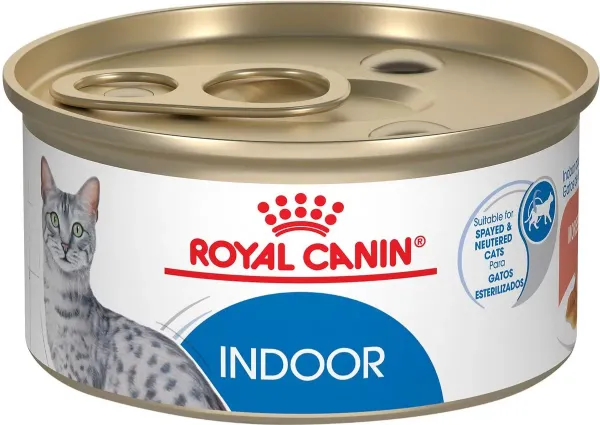
Royal Canin Feline Health Nutrition Indoor Adult Morsels in Gravy Canned Cat Food, 3-oz, case of 24
Health Benefits of Wet Cat Food
Urinary Tract Health
Cats fed moisture-rich diets experience measurable improvements in urinary tract function and disease prevention:
- Preventing Crystals and Stones: The high water content in moisture-rich diets dilutes urine, reducing concentrations of minerals like struvite and calcium oxalate that contribute to crystal formation. Studies show increased urine volume correlates with fewer blockages, particularly in male cats prone to urethral obstructions.
- Lower Risk of Infections: Hydration supports frequent urination, flushing pathogens from the urinary tract, and maintaining epithelial integrity. This aligns with clinical observations linking wet food consumption to reduced incidence of cystitis and bacterial infections.
Weight Management
The unique composition of moisture-rich diets addresses obesity, a prevalent issue in sedentary felines:
- Lower Calorie Density: With 70–78% moisture, these diets deliver fewer metabolizable calories per gram compared to dry food. The added water creates satiety without excess energy intake, aiding portion control.
- Maintaining a Healthy Weight: High-protein, low-carb formulations preserve lean mass while curbing fat accumulation. Research indicates that ats on moisture-rich diets are 30% less likely to develop obesity-related insulin resistance, a precursor to diabetes.
Dental Health
While moisture-rich diets don’t replace oral care, they complement hygiene practices:
- Debating Dental Impact: Contrary to assumptions, studies show plaque accumulation stems more from systemic factors (e.g., saliva pH, bacterial load) than food texture. Moisture-rich diets may even reduce tartar by minimizing kibble residue.
- Complementary Dental Practices: Veterinarians recommend pairing moisture-rich meals with daily brushing and enzymatic dental treats to optimize oral health. This dual approach reduces gingivitis risks more effectively than dry food alone.
Support for Specific Conditions
Tailored nutrition in moisture-rich diets addresses chronic and age-related ailments:
- Diabetes Management: Low-carbohydrate formulations stabilize postprandial glucose spikes, improving glycemic control. Clinical trials note diabetic cats on moisture-rich diets require 25% lower insulin doses compared to those on high-carb dry food.
- Kidney Disease Support: Advanced kidney function relies on consistent hydration to filter toxins efficiently. Moisture-rich diets mitigate renal stress by maintaining urine flow and providing highly digestible proteins, which reduce nitrogenous waste.
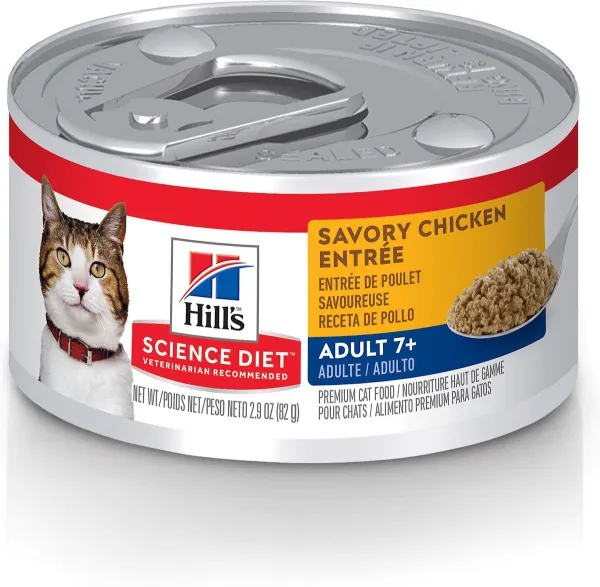
Hill’s Science Diet Senior Adult 7+ Savory Chicken Entree Canned Cat Food
Choosing the Right Wet Cat Food
Key Ingredients to Look For
A high-quality, moisture-rich diet prioritizes bioavailable nutrients that align with feline physiology:
- High-Quality Proteins: Focus on recipes featuring named animal proteins like chicken, turkey, or salmon as primary ingredients. These support lean muscle maintenance and metabolic health, unlike plant-based alternatives that lack essential amino acids.
- Essential Fatty Acids: Omega-3 and omega-6 fatty acids, often derived from fish oils or flaxseed, promote coat vitality and cognitive function without excessive saturated fats.
Avoiding Fillers and Low-Quality Additives
Nutritional integrity hinges on avoiding ingredients that dilute biological value:
- Artificial Fillers and By-Products: Steer clear of vague “meat by-products” or plant-derived fillers like corn gluten meal, which offer minimal digestibility and may trigger sensitivities.
- Excess Carbohydrates: Limit formulas with starchy thickeners (e.g., wheat, soy) that increase caloric density without nutritional benefit, contradicting feline carb intolerance.
Reading Pet Food Labels
Decoding labels ensures alignment with feline-specific needs:
- AAFCO Standards: Verify the product meets Association of American Feed Control Officials (AAFCO) nutrient profiles for your cat’s life stage. This guarantees adequacy in taurine, arachidonic acid, and other feline-essential nutrients.
- Life-Stage Appropriateness: Kittens require higher energy density, while senior recipes often emphasize joint-supporting glucosamine or reduced phosphorus for kidney health.
Veterinary Guidance
Personalized nutrition plans optimize health outcomes:
- Tailored Recommendations: Veterinarians can identify formulas suited to specific needs, such as low-phosphorus diets for chronic kidney disease or high-protein options for diabetic cats.
- Monitoring Health Metrics: Regular check-ups help adjust feeding strategies based on weight, hydration status, or emerging conditions, ensuring long-term wellness.
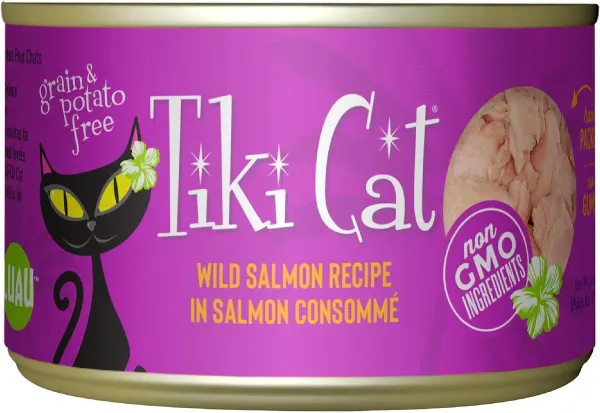
Tiki Cat Luau Wild Salmon in Salmon Consomme Grain-Free Canned Cat Food
Common Myths and Misconceptions
Myth: Wet Food Causes Tooth Decay
Dental health in cats hinges on oral hygiene practices, not solely food texture:
- Debunking the Myth: While plaque formation is influenced by bacterial load, saliva pH, and chewing behavior, no direct evidence links wet food to increased tooth decay. Studies emphasize that daily brushing and enzymatic cleaners are far more impactful than food type.
- Role of Diet: Moisture-rich diets often exclude starchy binders found in dry kibble, reducing carbohydrate residue that could fuel plaque growth. Pairing wet meals with dental treats or raw meaty bones further supports oral health.
Myth: Dry Food Suffices for Hydration
Cats’ evolutionary biology makes dry diets inadequate for meeting hydration needs:
- Physiological Reality: With only 6–10% moisture, dry food falls far short of the 70–78% water content in wet diets. This mismatch forces cats to compensate through drinking—a behavior they’re poorly wired for.
- Health Risks: Chronic low hydration increases susceptibility to urinary tract issues and kidney dysfunction. Even “hydration-focused” dry formulas cannot replicate the sustained urine dilution achieved through consistent moisture intake.
Myth: Wet Food Is Too Expensive
Cost considerations must account for long-term health benefits and portion efficiency:
- Portion Control Advantages: High water content creates satiety with fewer calories, reducing overfeeding risks and associated obesity-related costs (e.g., diabetes management, joint supplements).
- Preventative Health Investment: Premium wet diets, like those using human-grade ingredients (e.g., chicken breast or wild-caught fish), may lower veterinary expenses tied to chronic diseases like chronic kidney disease or urinary stones.
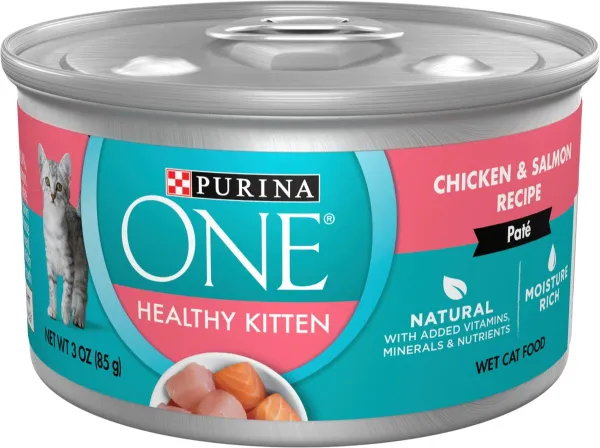
Purina ONE Grain-Free Natural Pate Healthy Kitten Chicken & Salmon Recipe Wet Kitten Food, 3-oz can, case of 24
Transitioning Your Cat to Wet Food
Sudden dietary shifts can disrupt a cat’s sensitive digestive system. A phased approach ensures acceptance and minimizes gastrointestinal upset:
Days 1–3: Mix 25% moisture-rich diet with 75% current food. This introduces the new texture while maintaining familiarity.
Days 4–6: Increase to 50% moisture-rich diet. Monitor stool consistency and appetite adjustments.
Days 7–10: Shift to 75% moisture-rich diet. By this stage, most cats have adapted to the enhanced hydration and protein content.
Full Transition: By day 10–14, complete the switch. Slow adaptation aligns with feline metabolic needs, reducing the risks of nausea or food aversion.
Always refrigerate unused portions and warm meals to body temperature (98–100°F) to mimic prey warmth, enhancing palatability.
Handling Picky Eaters
Cats are notoriously selective due to their hypercarnivorous instincts. Tailor approaches to individual preferences:
- Texture Trials: Offer varieties like pâté, chunks in gravy, or shredded formats. Some cats prefer the smooth consistency of pâté, while others favor meaty pieces.
- Aroma Enhancement: Gently warm food to release volatile compounds, amplifying the scent of animal proteins—a critical factor for cats with diminished olfactory senses.
- Flavor Pairing: Top moisture-rich meals with a sprinkle of freeze-dried chicken liver or a drizzle of fish oil to entice reluctant eaters.
- Scheduled Feeding: Remove uneaten portions after 30 minutes to prevent spoilage, then retry at the next mealtime. Consistency builds a routine without forcing consumption. For cats resistant to change, blend a small amount of moisture-rich diet with their favorite dry kibble initially. Gradually reduce the kibble ratio as acceptance grows.
Conclusion
The advantages of moisture-rich diets are rooted in their alignment with feline biology and clinical research:
- Hydration Support: With water content exceeding 70%, these diets address cats’ low thirst drive, reducing risks of dehydration and urinary tract issues.
- Muscle Maintenance: High-protein formulations preserve lean mass, particularly during weight loss or aging, thanks to bioavailable animal-based proteins.
- Weight Management: Lower caloric density and increased satiety help prevent obesity, a growing concern for indoor felines.
- Urinary and Kidney Health: Consistent hydration dilutes urine, lowering the incidence of crystals and chronic kidney disease.
- Recovery and Immunity: Studies show moisture-rich diets enhance antioxidant activity, reduce post-surgical pain, and support immune resilience.
Holistic Approach
While moisture-rich diets offer profound benefits, they work best as part of a comprehensive nutritional strategy:
- Balanced Nutrition: Pair moisture-rich meals with high-quality dry food or supplements to meet AAFCO standards for life-stage-specific needs. This ensures adequate intake of taurine, arachidonic acid, and other feline-essential nutrients.
- Veterinary Collaboration: Regular consultations help tailor diets to individual health profiles, such as low-phosphorus formulas for kidney support or high-protein options for diabetic cats.
By prioritizing species-specific nutrition and proactive veterinary care, pet owners can unlock the full potential of moisture-rich diets, fostering longevity and vitality in their feline companions.


